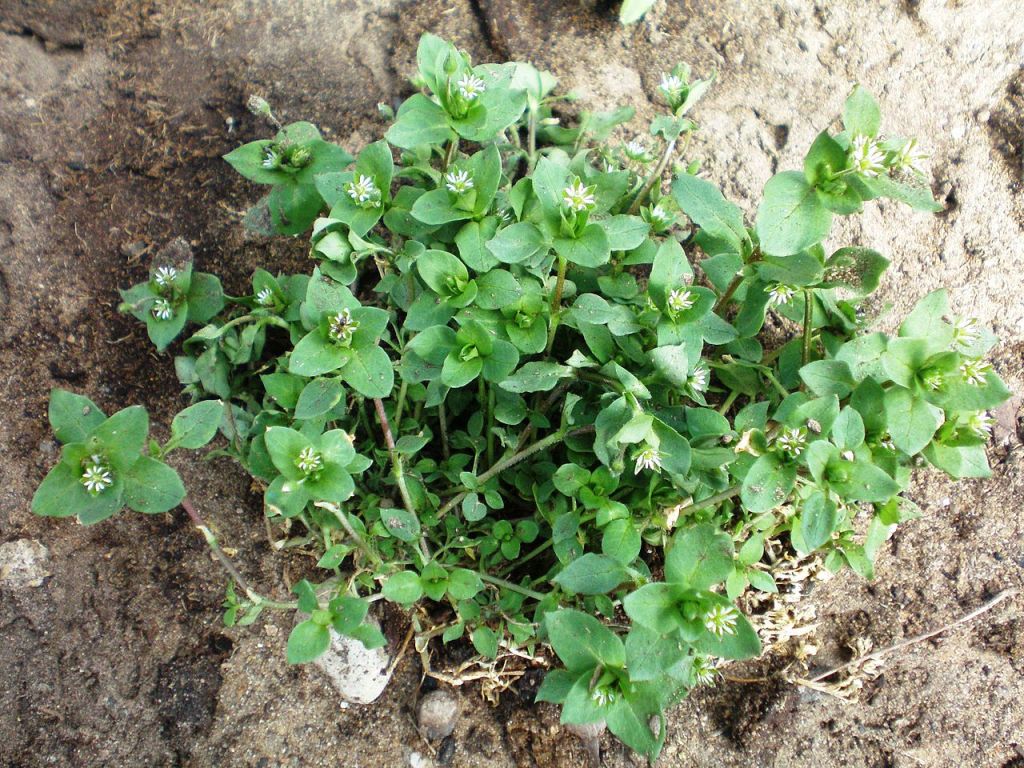
Chickweed or Stellaria media
is one of the weeds mentioned on the RHS site.
So a good reason for a post on this plant and its relatives!
The Caryophyllaceae or Pink/Campion Family is a large family in the B.I. It is therefore subdivided into 3 Subfamilies:
- 1 Subfamily Alsinoideae with 11 genera (genera 1-11) covered in this week’s post.
- 2 Subfamily Paronychioideae with 5 genera (genera 12-17)
- 3 Subfamily Caryophylloideae with 6 genera (genera 18-24)
Links on the scientific names is info from the Plant Atlas 2020. Links on the common names are often Wikipedia, where you can also find pictures in Wikipedia Commons or occasionally from another website. The coloured backgrounds are blue for the habitat information as found in the Online Plant Atlas 2020 as well as for general interesting facts. Green is for all sorts of uses such as food, ornamental, wildlife, etc. Pink is for medicinal use.
If described in the Flora of Birmingham and the Black Country it will be highlighted by FBBC in the Content page.
Contents of Subfamily Alsinoideae:
1 Arenaria spp. or Sandworts
- A. serpyllifolia or Thyme-leaved Sandwort FBBC
- A. leptoclados or Slender Sandwort FBBC
- A. norvegia with 2 subspecies: ssp norvegia or Arctic Sandwort and ssp anglica or English Sandwort
- A. ciliata or Fringed Sandwort
- A. balearica or Mossy Sandwort FBBC
- A. montana or Large-flowered Sandwort
2 Moehringia trinervia or Three-nerved Sandwort FBBC
3 Honckenya peploides or Sea Sandwort
4 Minuartia spp.
- M. recurva or Recurved Sandwort
5 Sabulina tenuifolia or Fine-leaved Sandwort
- S. verna or Spring Sandwort
- S. rubella or Mountain Sandwort
- S. stricta or Teesdale Sandwort
6 Cherleria sedoides or Cyphel
7 Stellaria spp or Chickweeds
Stellaria media or Chickweed FBBC
- S. nemorum or Wood Stitchwort FBBC
- S. pallida or Lesser Chickweed FBBC
- S. neglecta or Greater Chickweed FBBC
- S. holostea or Greater Stitchwort FBBC
- S. palustris or Marsh Stitchwort
- S. graminea or Lesser Stitchwort FBBC
- S. alsine or Bog Stitchwort FBBC
- S. aquatica or Water Chickweed (syn. Myosoton aquaticum) FBBC
8 Holosteum umbellatum or Jagged Chickweed
9 Cerastium spp or Mouse-Ears
- C. cerastoides or Starwort Mouse-ear
- C. arvense or Field Mouse-ear FBBC
- C. arvense x C. tomentosum or Hybrid Mouse-Ear FBBC
- C. tomentosum or Snow-in-summer FBBC
- C. alpinum or Alpine Mouse-ear
- C. nigrescens or Arctic Mouse-ear
- C. fontanum or Common Mouse-ear FBBC
- C. glomeratum or Sticky Mouse-ear FBBC
- C. brachypetalum or Grey mouse-ear
- C. diffusum or Sea Mouse-ear FBBC
- C. pumilum or Dwarf Mouse-ear
- C. semidecandrum or Little Mouse-ear FBBC
10 Moenchia erecta or Upright Chickweed FBBC
11 Sagina spp or Pearlworts
- S. nodosa or Knotted Pearlwort FBBC
- S. nivalis or Snow Pearlwort
- S. subulata or Heath Pearlwort
- S. saginoides or Alpine Pearlwort
- S. x normaniana or Scottish Pearlwort
- S. procumbens or Procumbent Pearlwort FBBC
- S. apetala or Annual Pearlwort FBBC
- S. filicaulis or Slender Pearlwort FBBC
- S. maritima or Sea Pearlwort
12 Scleranthus spp or Knawels
- S. perennis or Perennial Knawel with 2 subspecies: ssp. perennis and ssp. prostratus
- S. annuus or Annual Knawewel with 2 subspecies: ssp. annuus and ssp. polycarpos FBBC
1 Arenaria spp. or Sandworts
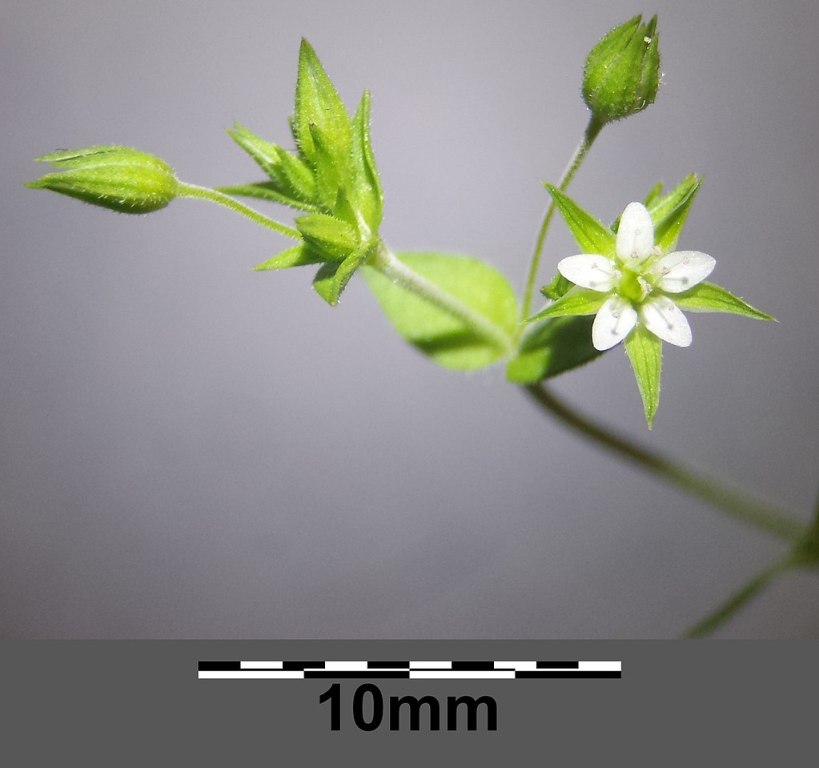
A winter- or rarely summer-annual of dry, open sites, such as disturbed ground and anthills on chalk and limestone downs, sand dunes and other sandy and gravelly places, rabbit warrens, arable fields, roadsides, railways, quarries, rock ledges, walls, spoil-tips and waste ground.
The entire plant is used as a pot-herb.
A decoction of the leaves is used in the treatment of dysentery. It is also used in the treatment of bladder complaints, calculus troubles and acute and chronic cystitis.
A winter- or rarely summer-annual of dry, open sites in similar habitats to those of A. serpyllifolia s.s. but with a stronger preference for cultivated and waste ground, old walls and quarries (Grose, 1957). It is also found in bare soil in calcareous grassland, on roadsides and railway tracks.
- A. norvegia with 2 subspecies: ssp norvegia or Arctic Sandwort and ssp anglica or English Sandwort
- A. ciliata or Fringed Sandwort
- A. balearica or Mossy Sandwort
- A. montana or Large-flowered Sandwort
This is an ornamental plant useful for on a rockery.
2 Moehringia trinervia or Three-nerved Sandwort
An annual herb of open, moist, ground in woodland but also in shaded hedgebanks, and rarely in unshaded places such as on walls and railway banks. It favours slightly acidic substrates, and there is a slight preference for warmer slopes in woodland, which hastens the successful completion of its life-cycle.
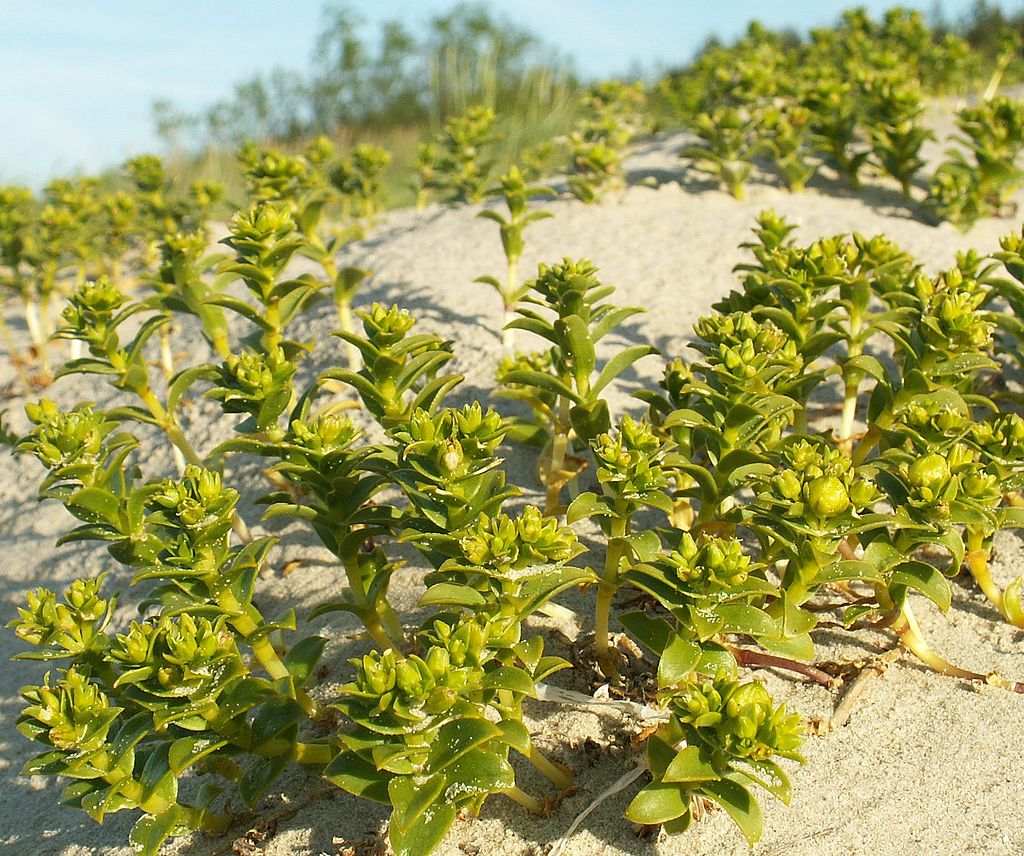
3 Honckenya peploides or Sea Sandwort
A succulent perennial herb with creeping stolons that make it well adapted to growing in mobile substrates. It often occurs in abundance on shingle beaches, and on shifting sand in foreshore communities where it is a pioneer colonist with plants such as Elymus junceiformis.
Both the leaves and the seeds are used as food. The shoots and leaves are rich in vitamin A and vitamin C and can be used as a green leafy vegetable either raw or cooked.
They can also be fermented to prepare a sauerkraut-like preserve, and in Iceland are fermented in whey to produce a drink. The seeds are small in size and time-consuming to gather; they can be ground up and added to flour or used as a garnish.
Good pictures can be found on Wikimedia Commons.
4 Minuartia and former Minuartia species:
5 Sabulina tenuifolia or Fine-leaved Sandwort
An annual herb of drought-prone soils with low competition. Its natural habitat is open, disturbed calcareous grassland on chalk and limestone although it is now more frequent in man-made habitats such as abandoned sandy arable fields on chalk, quarries, chalk soil heaps, the mortared walls of old ruins and buildings, the disturbed edges of tracks, railway banks and sidings.
- S. verna or Spring Sandwort
- S. rubella or Mountain Sandwort and see RBG Kew database
- S. stricta or Teesdale Sandwort
6 Cherleria sedoides or Cyphel
7 Stellaria spp or Chickweeds
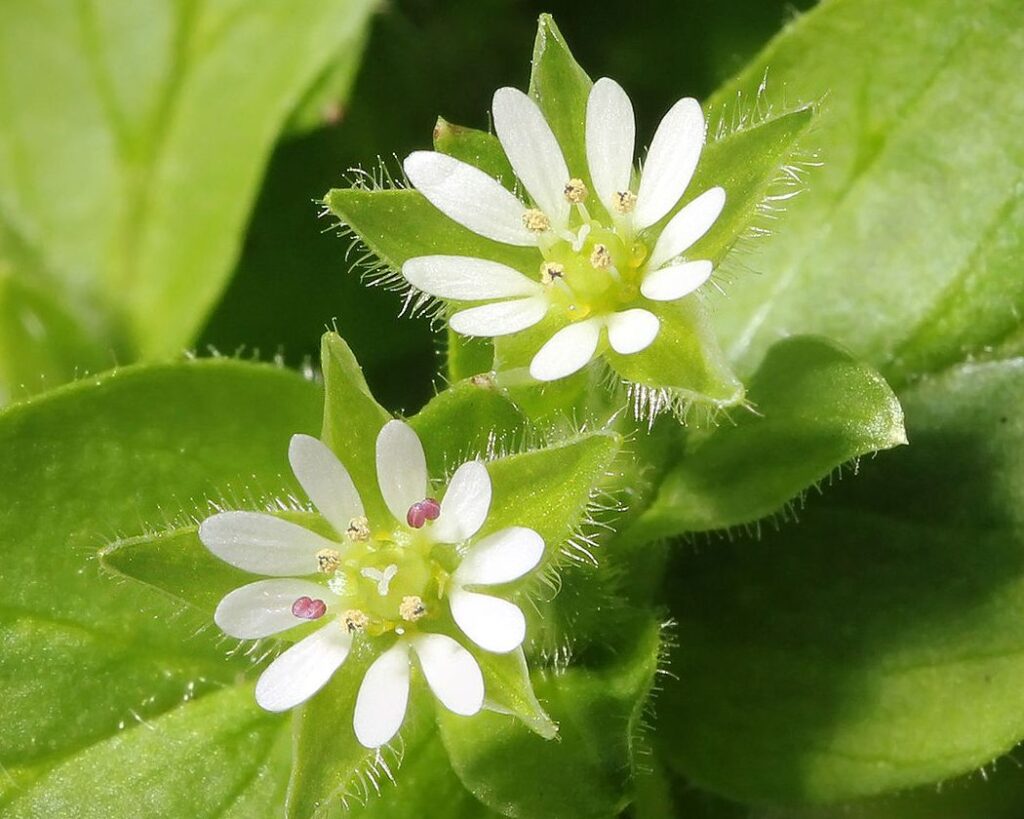
Stellaria media or Chickweed
Its tiny flowers are star-like (‘Stella’) and it is middle-sized (‘media’) between its smaller and larger brethren.
It is an annual or even an ephemeral, which is to say that its life cycle is very short: it may flower a few times in the course of a single year and its stems and leaves may persist for all twelve months. It has bright green, watery leaves which grow rapidly especially in fertile soils. It also produces large quantities of seed which germinate easily in favourable conditions.
Hedgerow Medicine has a good chapter praising Chickweed:
‘This is the best-known herbal remedy for itchy skin and hot skin inflammations of various types. Chickweed is a soothing, nutritious and cooling herb, with a reputation for clearing stubborn, long-lasting bodily conditions.It has special affinities for the eyes, lungs and chest, and can be eaten as a food. As you’ll see, it is far more than chickenfeed!’
Edible Uses:
- It has long been eaten by country people as a salad plant or as a vegetable, treated like spinach.
- With minerals and vitamin C it is nutritious and may, like cress, garnish a sandwich.
- Poultry keepers know how avidly the birds eat the leaves and the fruits.
- It is one of the ingredients of the symbolic dish consumed in the Japanese spring-time festival, Nanakusa-no-sekku.
S. media contains plant chemicals known as saponins, which can be toxic to some species when consumed in large quantities. Chickweed has been known to cause saponin poisoning in cattle. However, as the animal must consume several kilos of chickweed in order to reach a toxic level, such deaths are extremely rare.
Traditional Medicine Use:
The plant has medicinal properties and is used in folk medicine. It has been used as a remedy to treat itchy skin conditions and pulmonary diseases. The 17th century herbalist John Gerard recommended it as a remedy for mange. The plant was used by the Ainu for treating bruises and aching bones. Stems were steeped in hot water before being applied externally to affected areas.
Medicinal Uses:
- It is used to soothe itchy and irritable skin conditions. Although the most common application is on the skin,
- It may be taken internally as a remineraliser especially in depleted, rheumatic individuals.
- Father Kneipp would have us extend its obvious soothing influence to the respiratory tract where it would combine well with Marshmallow leaves and Primrose flowers or root.
- Modern herbalists prescribe it for iron-deficiency anaemia (for its high iron content), as well as for skin diseases, bronchitis, rheumatic pains, arthritis and period pain. Not all of these uses are supported by scientific evidence.
Other uses:
- It favours rich, organic and moisture retentive soils and can grow into large groundcovering plants. With all this greenmatter it protects the bare soil from the elements or can be added to the compost heap when we need to use the soil.
- It is a favoured food of finches and many other seed-eating birds.
- Chickweeds are used as food plants by the larvae of some Lepidoptera species including Angle Shades, Heart and Dart, Riband Wave, Setaceous Hebrew Character and the Coleophora case-bearers C. coenosipennella (feeds exclusively on Stellaria spp), C. lineolea (recorded on S. graminea), C. lithargyrinella (recorded on S. holostea), C. solitariella (feeds exclusively on S. holostea) and C. striatipennella.
other Stellaria spp. or Chickweeds and Stitchworts.
There are 8 other species of Stellaria. They will all have similar uses as above.
- S. nemorum or Wood Stitchwort
- S. pallida or Lesser Chickweed
- S. neglecta or Greater Chickweed
- S. aquatica or Water Chickweed
A perennial herb of damp or wet habitats, including damp woods, alder- and willow-carr, the banks of rivers, streams, canals and ditches, by ponds and in marshes and other wet places. It has been recorded on newly surfaced forestry rides, and can also tolerate occasional flooding by brackish water.
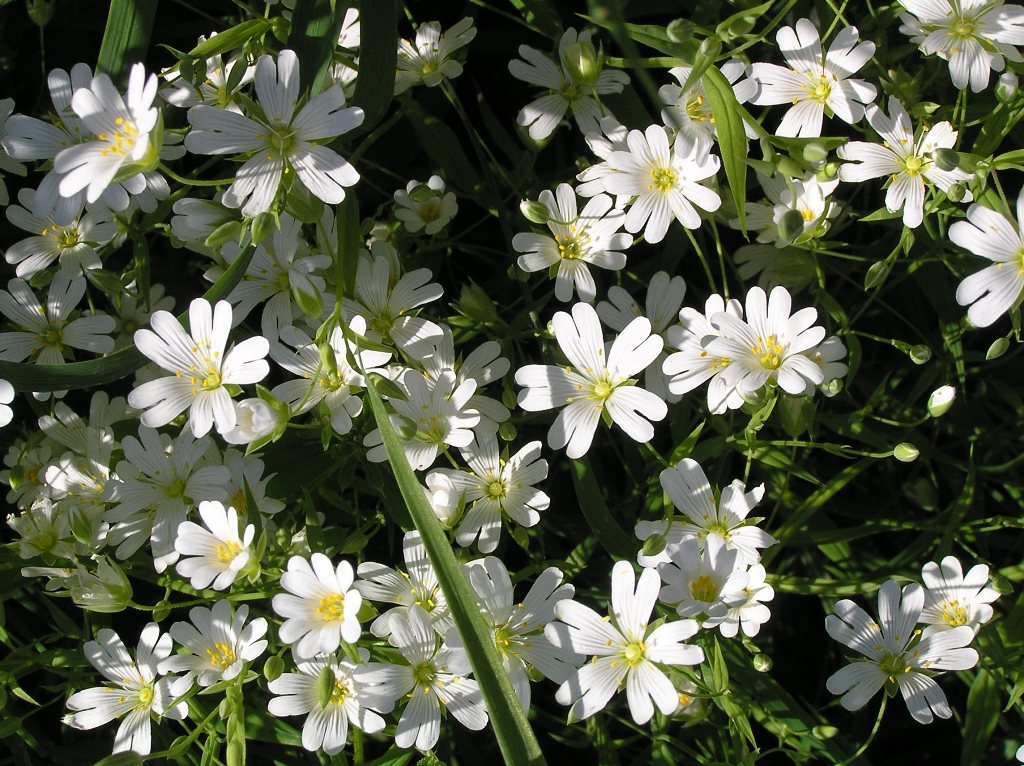
A winter-green perennial herb of shady hedgerows, copses, woodland margins, deciduous woodland, wayside verges and unmanaged grassy roadsides. It tolerates a wide range of soils, but does best on those that are moist, mildly acid and infertile. It avoids the most freely drained substrates or waterlogged conditions, and so may be confined to slopes in wetter sites.
This plant was once used as a herbal remedy for a stitch (the pain sometimes felt in the side during exercise), hence the name ‘stitchwort’. It has also been called the ‘poor man’s buttonhole’, presumably because it was once used as a buttonhole.
A perennial herb of damp or free-draining, neutral and acidic soils. Habitats include woodland clearings, hay meadows, rough grasslands, heaths, hedgebanks and waysides. It is tolerant of some nutrient enrichment and is often a constituent of neglected pasture.
8 Holosteum umbellatum or Jagged Chickweed (an extinct neophyte)
9 Cerastium spp or Mouse-Ears
Cerastium is derived from the Greek word for ‘horned’, in reference to the shape of its fruit capsule.
There are 11 species of Mouse-ears described in the Plant Atlas 2020. The most obvious difference with the above genus Stellaria is that it is mostly from dryer habitats and therefore has more hairy leaves and stems instead of a succulent look. Some good pictures and descriptions of four species can be found here.
Cerastium tomentosum or Snow-in-Summer is an introduced species sometimes seen in gardens. This plant is not very demanding: it likes a poor soil, rich in gravel, well drained, in a sunny place.
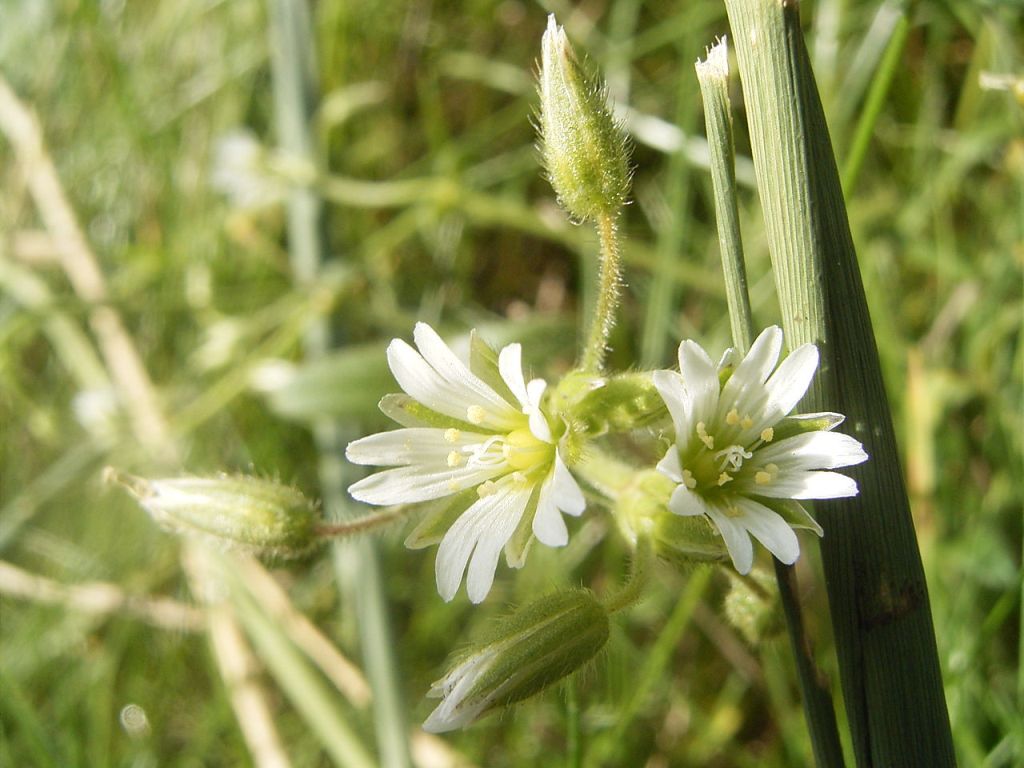
Leaves and young stems can be eaten raw or cooked. This also applies for the next species.
In Nepal, the juice of this plant was applied to the forehead to relieve headaches. The juice could also be dropped into the nostrils to treat nosebleeds.
- C. brachypetalum or Grey mouse-ear (Neophyte)
- C. diffusum or Sea Mouse-ear
- C. pumilum or Dwarf Mouse-ear
- C. semidecandrum or Little Mouse-ear
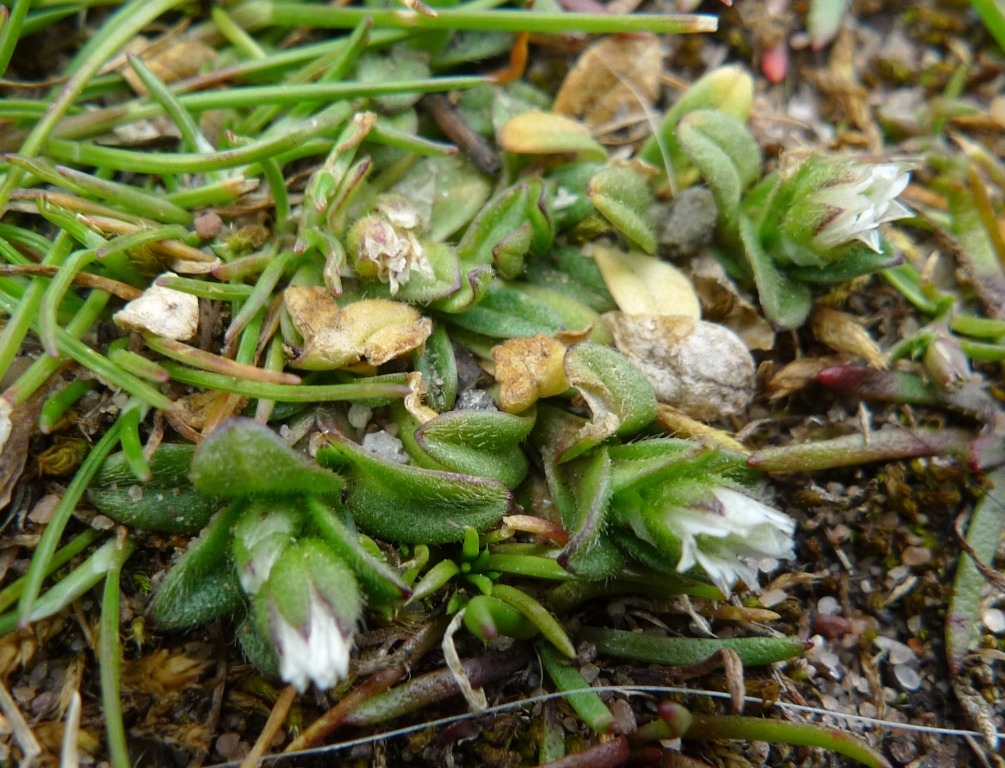
10 Moenchia erecta or Upright Chickweed
An annual herb of summer-droughted soils in tightly grazed grasslands and heathlands, on cliff-tops, pathsides, coastal dunes and sandy shingle, usually in open patches where competition is reduced. It is also found in quarries and sand-pits, and on other disturbed ground.
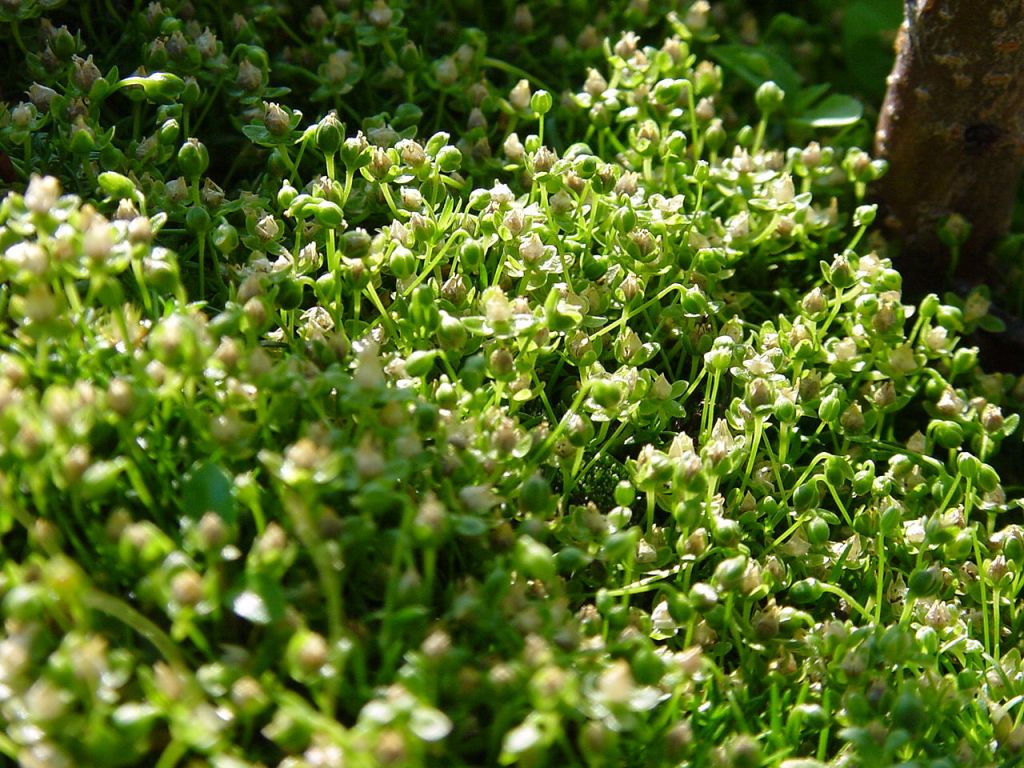
11 Sagina spp or Pearlworts
There are two varieties, Sagina subulata var. subulata with glandular-hairy sepals, and Sagina subulata var. glabrata Gillot with hairless sepals; the latter is often a lawn weed, and has been confused with the related Mediterranean species Sagina pilifera. The cultivar ‘Aurea’ (referred to as Scottish or Scotch Moss in the horticultural trade) is grown as a garden plant.
- S. saginoides or Alpine Pearlwort
- S. x normaniana or Scottish Pearlwort
- S. procumbens or Procumbent Pearlwort
A prostrate mat-forming perennial herb tolerant of heavy trampling and a large range of soil and environmental conditions, particularly bare ground. Its natural habitats include open, damp soils on rocks, cliffs, streamsides and riverbanks, but it is probably more frequent in fertile, disturbed habitats created by humans including lawns, paths, pavement cracks, wall tops, banks, ditchsides, roadside verges, pasture, arable fields, spoil heaps and mining waste. It is considered a horticultural weed and regularly appears in gardens, plant pots and containers.
It has several myths, legends and magic mentioned in Wikipedia: It is said to have been the first plant on which Christ set his foot when he came to Earth, or when he rose from the dead.
In the highlands of Scotland it was supposed to have derived supernatural powers from having been blessed by Christ, St Bride and St Columba. A spray of it hung from the door lintel gave protection against fairies, especially those who made a practise of spiriting people away.
If pearlwort were stuck in a bull’s fore-hooves, the cows with which it mated and the calves and the milk they produced were safeguarded from ills. If a cow ate the herb, its calves and milk, and all who drank the milk, were also protected against fairies.
For the young village maiden, pearlwort brought a bonus. If drunk in an infusion, or used merely to wet the lips, it would attract her favoured lover, and if a piece of it were in the girl’s mouth when she kissed him, he was bound to her for ever.
12 Scleranthus spp or Knawels
- S. perennis or Perennial Knawel with 2 subspecies: ssp. perennis and ssp. prostratus (both subspecies are very rare)
The plant used to be economically significant as the major host plant of the Polish cochineal.
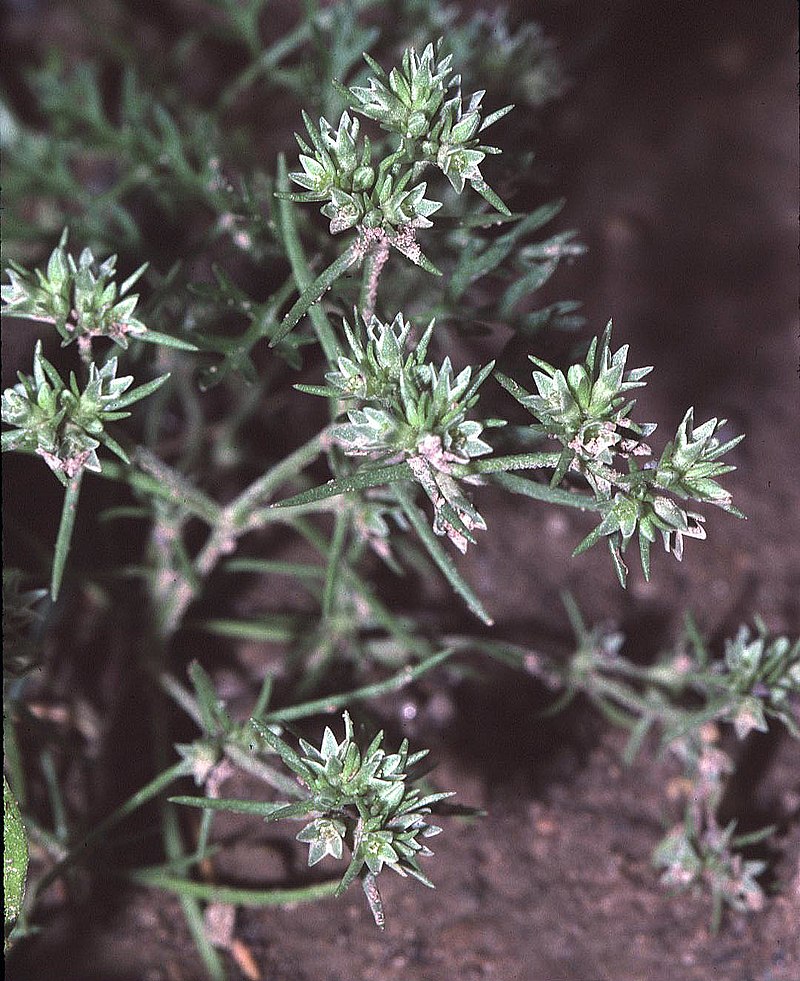
- S. annuus or Annual Knawel with 2 subspecies: ssp. annuus and ssp. polycarpos
Medicinal Uses according to the Bach Flower Remedy:
Scleranthus is a Bach Flower Remedy that assists in restoring the attributes of equilibrium as well as determination in one’s character. Scleranthus is a remedy that is also recommended for treating mood swings – happy at one moment and sad in the next moment, and it has also been found to be effective in other conditions wherein the balance of an individual is upset, for instance, in the case of motion sickness.
More about other useful as well as pretty Caryophyllaceae in next week’s blog!
